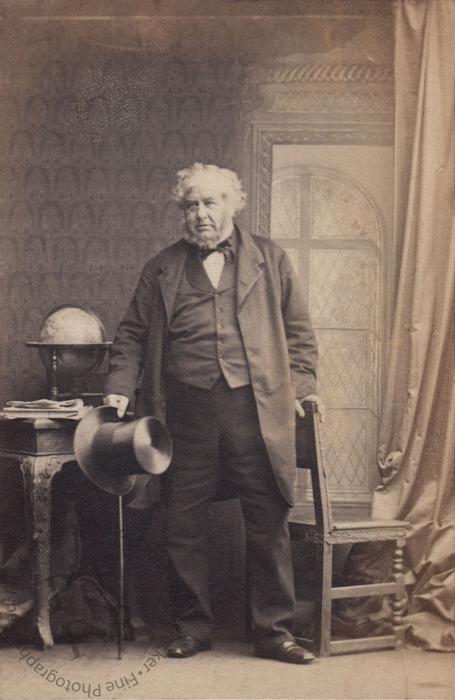Duncan Dunbar Esq,
(1803-1862)
18 January 1862
Volume 5, page 324, sitting number 6792.
[This was the sitter’s second visit to Silvy’s studio. His previous sitting (volume 5, page 195, sitting number 6274) had been on 29 October 1861.]
Born on 8 September 1803 at 7 Fore Street in London’s Limehouse, Duncan Dunbar was baptised on 27 May 1807 at St Anne’s, Limehouse. His father was the successful brewer and wine merchant Duncan Dunbar, who later branched out as a shipowner.
When he was 22 years old, he and his brother inherited their father’s business. Duncan eventually owned the largest shipping line in Great Britain. Most of his ships were built at his own shipyard at Moulmein (present day Mawlamyine) in Burma. In 1852 he also established the London Chartered Bank of Australia.
Duncan Dunbar died a few weeks after this portrait was taken on 6 March 1862 at his home, 50 Porchester Terrace, a few doors from Silvy’s studio. According to the Dublin Evening Mail (6 March 1862), ‘he died most suddenly […] while in the act of dressing.’
‘Great gloom was thrown over the City this morning by the announced sudden demise of Mr Duncan Dunbar, one of the most enterprising and well-positioned members of the mercantile community. It appears he was struck with apoplexy this morning while dressing, and never recovered. The intelligence was received everywhere with regret, and at the Stock Exchange it caused heaviness in several descriptions of securities. He was chairman of the London Chartered Bank of Australia, a director of the Alliance, Marine and other insurance companies, and was, it is said, considerably interested in the Scottish Australian Investment and Scottish Australian Mining Companies. […] Mr Dunbar has frequently been requested to represent various places in parliament, and he was only recently asked to stand for the City of London, but he steadfastly refused all invitations of the kind, particularly on the ground of a studious avoidance of late hours, which he considered might interfere with his health’ (London Evening Standard, 6 March 1862).
According to John Bull (8 March 1862), ‘He was the owner of the largest private fleet of merchant vessels in the world, the number being fifty-two, almost all of large size first-class vessels, and his wealth is estimated to represent nearly £2,000,000, but which, subject to realization, will probably not fetch anything like so large a sum. […] He leaves no one behind him to perpetuate his name and represent him in the world in which he attained to so distinguished a place.’ The Banffshire Journal (11 March 1862) thought that ‘probably no man, within the last forty years, has transacted such an extent of business directly, and by means of his own personal agency.’
One newspaper reported that ‘He is said to have been a hard and exacting man, and notwithstanding all his immense wealth, there is no instance known of his having contributed a shilling to any charitable purpose’ (Tavistock Gazette, 14 March 1862).
He was buried on 14 March 1862 in London’s Highgate Cemetery. ‘Most of the shipping in the East India Docks had their colours hoisted half-mast high, as also the flags on the East and West India Docks’ (Edinburgh Evening Courant, 15 March 1862).
His estate was eventually valued at £1,000,000. His fortune was inherited by ‘his immediate relatives – his sisters Mrs Dunbar of Seapark, Forres, and Mrs Mason [sic], widow of the late Mr Mason [sic], merchant, London, and by his nieces’ (Inverness Courier, 13 March 1862).

